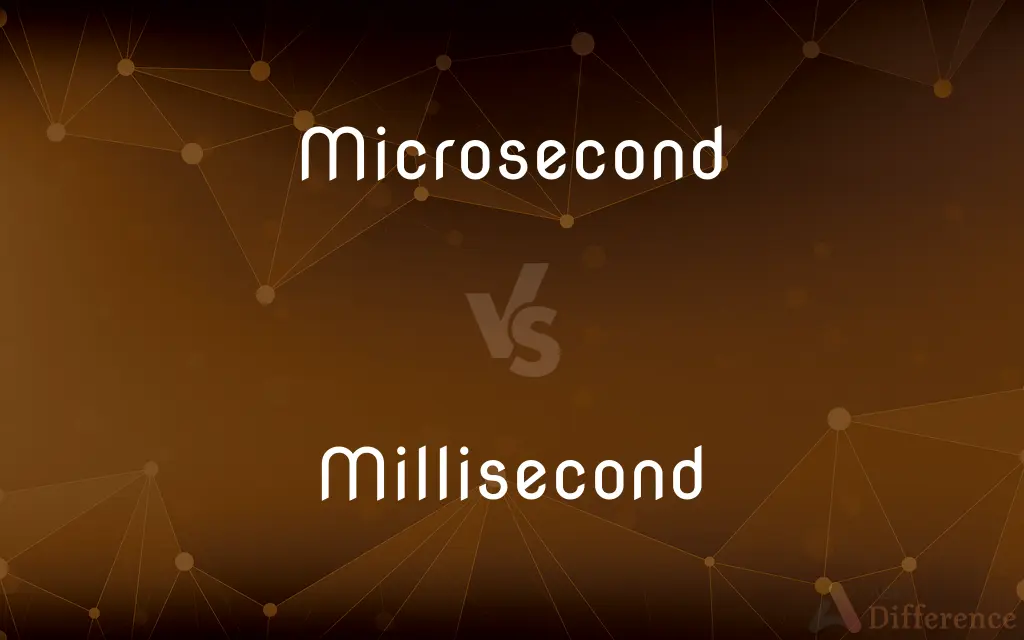Microsecond vs. Millisecond — What's the Difference?
By Urooj Arif & Fiza Rafique — Updated on March 28, 2024
A microsecond is one millionth of a second, whereas a millisecond is one thousandth of a second, making a microsecond a thousand times shorter.

Difference Between Microsecond and Millisecond
Table of Contents
ADVERTISEMENT
Key Differences
A microsecond (µs) represents a much shorter time frame than a millisecond (ms). In the realm of computing and electronics, microseconds are crucial for measuring the speed of processes or signals that occur extremely quickly. For instance, a microsecond might be used to gauge the time it takes for a processor to retrieve data from memory. On the other hand, milliseconds are commonly used in contexts where human perception is relevant, such as the responsiveness of a website or the refresh rate of a display, as these durations align more closely with the speed at which humans can detect delays or changes.
When it comes to applications, microseconds are often cited in scientific research, telecommunications, and high-speed computing, where precision and the ability to measure very brief intervals are paramount. Milliseconds, however, are more relevant in everyday technology interactions, gaming, and audio/video synchronization, where they help ensure a seamless user experience without perceptible lag.
The precision required for microseconds indicates a need for highly specialized equipment and scenarios where even the smallest fraction of time is significant. This is contrasted with milliseconds, which, while still requiring precision, are within the realm of human detection and therefore applicable to a broader range of more familiar activities and technologies.
The distinction between microseconds and milliseconds also highlights the scale at which different technologies operate. For example, network latency is often measured in milliseconds, as this unit of time is significant enough to affect user experience on the internet. Conversely, the internal clock speed of a computer's CPU might be considered in terms of microseconds, reflecting the incredibly rapid pace at which modern computers process information.
Comparison Chart
Definition
One millionth of a second
One thousandth of a second
ADVERTISEMENT
Symbol
µs
Ms
Relative Size
1/1,000,000 of a second
1/1,000 of a second
Use Cases
High-speed computing, scientific research
Web page loading, audio/video timing
Perception
Beyond human sensory detection
Often at the threshold of human perception
Compare with Definitions
Microsecond
Essential for understanding fast physical phenomena.
Microsecond precision is crucial in particle physics experiments.
Millisecond
In measuring internet speed and game responsiveness.
A low millisecond latency is vital for competitive online gaming.
Microsecond
Beyond the threshold of human perception.
Changes that happen in microseconds are imperceptible to humans.
Millisecond
A unit of time equal to one thousandth of a second.
The gamer experienced a 50 millisecond delay in response time.
Microsecond
A unit of time equal to one millionth of a second.
The precision laser equipment operates with an accuracy of a few microseconds.
Millisecond
More perceivable and broadly applicable.
Milliseconds are a common metric in user experience design, unlike microseconds.
Microsecond
In high-speed electronic circuits.
Signal processing in modern computers can occur in the range of microseconds.
Millisecond
Important in contexts where human perception is relevant.
Milliseconds matter in the synchronization of audio and video.
Microsecond
Far shorter and used in more specialized contexts.
Microsecond delays are critical in satellite communication, unlike millisecond delays.
Millisecond
Near the limit of human sensory detection.
Delays under 100 milliseconds are often imperceptible in user interfaces.
Microsecond
A microsecond is an SI unit of time equal to one millionth (0.000001 or 10−6 or 1⁄1,000,000) of a second. Its symbol is μs, sometimes simplified to us when Unicode is not available.
Millisecond
A millisecond (from milli- and second; symbol: ms) is a thousandth (0.001 or 10−3 or 1/1000) of a second.A unit of 10 milliseconds may be called a centisecond, and one of 100 milliseconds a decisecond, but these names are rarely used. Decisecond equals 1/10 of a second Centisecond equals 1/100 of a second Millisecond equals 1/1000 of a second To help compare orders of magnitude of different times, this page lists times between 10−3 seconds and 100 seconds (1 millisecond and one second).
Microsecond
One millionth (10-6) of a second.
Millisecond
One thousandth (10-3) of a second.
Microsecond
It is commonly represented with symbol µs.
Millisecond
One one-thousandth of a second. Symbol: ms.
Microsecond
One millionth of a second; one thousandth of a millisecond
Millisecond
One thousandth of a second
Common Curiosities
How do milliseconds affect user experience?
Milliseconds can impact the perceived responsiveness of websites and applications.
Can humans perceive events that occur in a microsecond?
No, events in the microsecond range are beyond human sensory perception.
Are there everyday situations where milliseconds are noticed?
Yes, in music, gaming, and multimedia, where timing and synchronization are key.
Why are microseconds important in computing?
They measure the incredibly fast operations within computer processors and data transfers.
What devices can measure time in microseconds?
Specialized electronic instruments and timers used in scientific and technical fields.
How do video games use milliseconds?
For frame rates and input lag, ensuring smooth gameplay and responsiveness.
Can a millisecond difference matter in sports?
Yes, in races or events where timing is crucial, milliseconds can determine winners.
Is there a psychological effect of millisecond delays in communication?
Yes, even slight delays can affect the natural flow of conversation or performance in real-time applications.
What is faster, a microsecond or a millisecond?
A microsecond is faster, being a thousand times shorter than a millisecond.
How do milliseconds and microseconds relate to network latency?
Network latency is often measured in milliseconds, affecting browsing and streaming quality.
Why might a scientist use microseconds in research?
To measure and understand phenomena that occur at very high speeds or short durations.
What practical applications rely on microseconds?
High-frequency trading and satellite communications rely on microsecond precision.
Can the difference between microseconds and milliseconds impact safety?
In systems like airbag deployment in cars, timing precision can be critical for safety.
How do microseconds and milliseconds apply to artificial intelligence?
AI processing and reaction times can benefit from the precision of microseconds in real-time decisions.
How does audio processing use milliseconds?
In sound engineering, milliseconds are crucial for delay effects and synchronization.
Share Your Discovery

Previous Comparison
Cheroot vs. Cigar
Next Comparison
Offender vs. PerpetratorAuthor Spotlight
Written by
Urooj ArifUrooj is a skilled content writer at Ask Difference, known for her exceptional ability to simplify complex topics into engaging and informative content. With a passion for research and a flair for clear, concise writing, she consistently delivers articles that resonate with our diverse audience.
Co-written by
Fiza RafiqueFiza Rafique is a skilled content writer at AskDifference.com, where she meticulously refines and enhances written pieces. Drawing from her vast editorial expertise, Fiza ensures clarity, accuracy, and precision in every article. Passionate about language, she continually seeks to elevate the quality of content for readers worldwide.













































